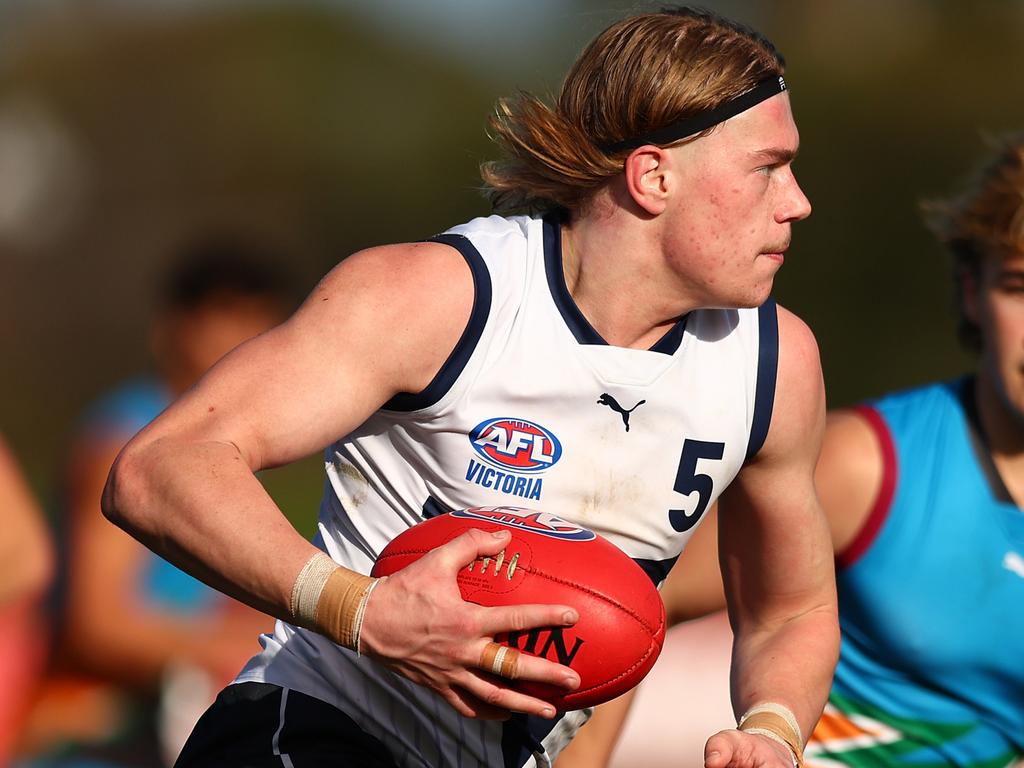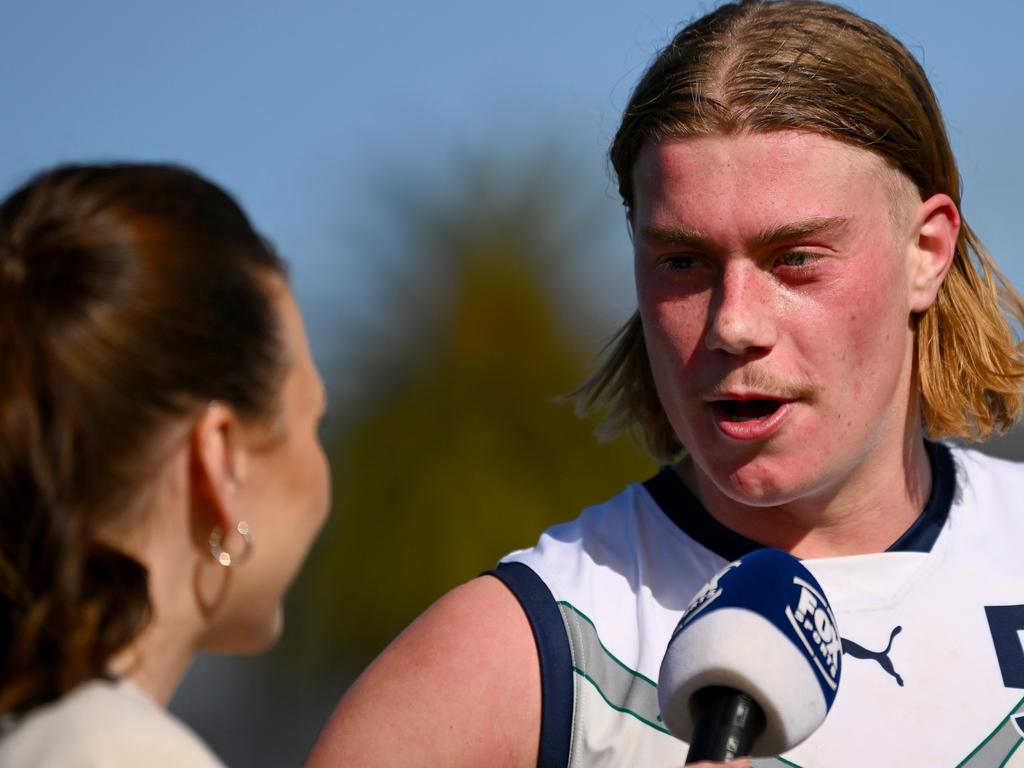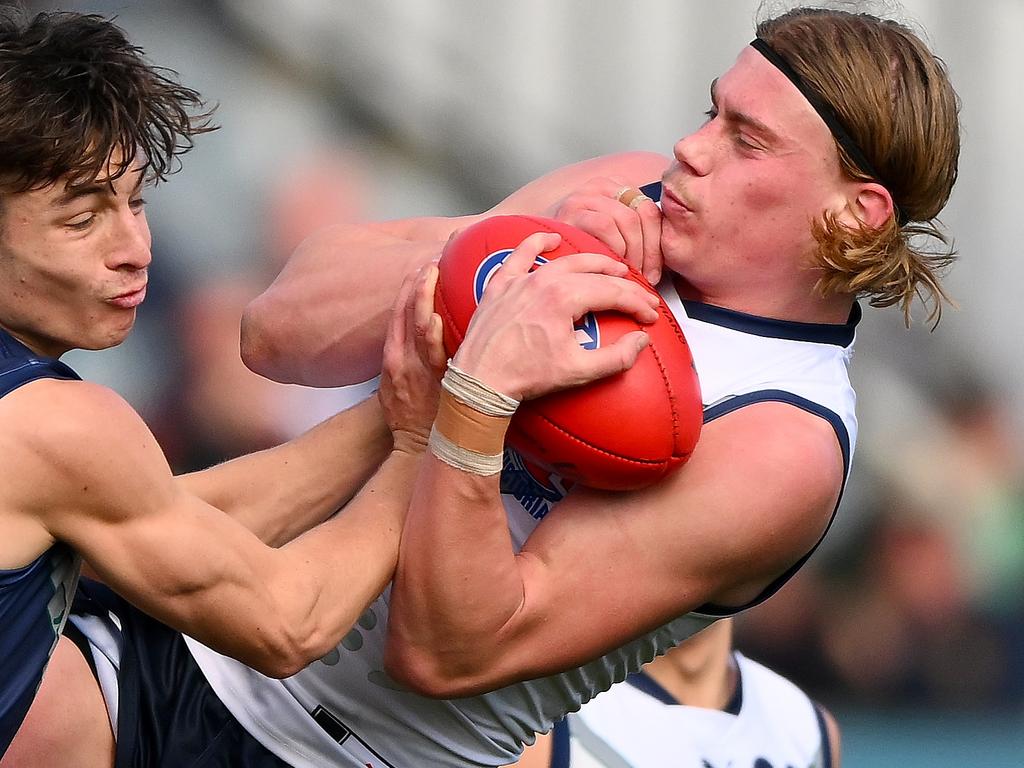The questions for the West Coast Eagles as they ponder trading number one pick and rights to Harley Reid
With time ticking, the arguments for the West Coast Eagles to take consensus number one draft pick Harley Reid or trade away the pick are equally compelling, as MARK DUFFIELD explains.

AFL
Don't miss out on the headlines from AFL. Followed categories will be added to My News.
To trade or not to trade? That is the question confronting West Coast.
When the trade in question is the number one draft pick and the player in question is Tongala’s finest Harley Reid, it makes the question the biggest one of this trade period.
The Eagles public position on this is pretty clear: They are determined to read Reid’s name out on draft night unless someone comes to them with an offer they can’t refuse.
Which will not be a Godfather-style horse’s head in the bed of an Eagles recruiter type of offer, but rather multiple draft picks so enticing for the Eagles that they are absolutely convinced they will win on the trade.
Which begs the question: if the Eagles have to be convinced they win on the trade – what is the point of any other club doing a trade where the other party is a clear winner?

But this is the AFL’s silly season – a season where a player like North Melbourne’s Ben McKay commands a pick three free agency compensation pick under the AFL’s secret herbs and spices formula when, at the end of 2013, Hawthorn received pick 19 for Lance Franklin when he accepted Sydney’s monster deal.
So whether we choose to call it silly, or crazy or enticing, here are the pros and cons of the Eagles trading away pick one and Harley Reid.
The case for trading:
Two (or three) players are better than one:
The Eagles have expressed the view that it would take something like North Melbourne offering them picks two and three and even something else as well to get their attention.
Let’s say the Eagles would be prepared to trade pick one for picks two and three.
Then look at the trade in a different way: Not Harley Reid for Colby McKercher and Daniel Curtin, but rather the second and third best talents the entire country’s talent development pathway can produce, up against the best.
Remember how Matt Rowell was considered a “generational talent” in 2019? Well 2 and 3 v 1 in that draft gives you Noah Anderson and Luke Jackson versus Rowell. Not hard to work out who wins there.

Retention:
Reid now says he is happy to come. He will be tied to the Eagles for three years. But every year he comes out of contract and maybe even the year before he comes out of contract there will be noise about him wanting to go home. Which means you will have to work harder to keep him happy and pay more to keep him. If one of the players the Eagles got in place of him was local product Curtin, that risk gets diluted straight away.
Spread the injury risk across more than one player:
Anthony Morabito wasn’t the number one pick in 2009, he was taken at pick four. He played just 26 AFL games.
Morabito could play.
At draft time he was considered by Fremantle a better prospect than Nathan Fyfe and the Dockers rated Fyfe more highly than all other clubs at the draft. In his third game Morabito kicked two stunning goals against reigning Premier Geelong.
He played 23 of 24 games in his first season, took 31 shots on goal for 13.18 and was good for 15 disposals, three inside fifties, three tackles and two clearances a game. But after barely being injured at all in junior ranks he suffered his first serious knee injury at the end of 2010, then another, then another. He played three games in 2014 then never played AFL again. Through no fault of anyone’s, a great talent and a genuine top five pick became a draft bust. The chances of “complete bust” are drastically reduced if you can spread the risk across more than one player.

How often does the nominal number one pick become the best player out of the draft?:
Looking at Reid and his highlights package now it is hard to believe he won’t be this year’s stand out. But history says that the best player in the draft eventually is usually not the number one pick.
Chris Judd was pick three in 2001, Lance Franklin was pick five in 2004, Scott Pendlebury pick five in 2005, Joel Selwood pick seven in 2006, Patrick Dangerfield pick 10 in 2007, Nic Naitanui pick two in 2008 and Dustin Martin pick three in 2009 from the first decade this century alone.
Marcus Bontempelli (four) and Christian Petracca (two) are more recent examples. The most important years of a young player‘s development come after being drafted and those years still lie ahead of Reid and the rest of this draft crop.
The case against trading
This kid looks like a stand out:
There might be important years of development ahead but all the traits are there – the speed, the power, the willingness to put his head in the hole, the skill, the ability to take a big mark, the ability to know a big moment. Get your hands on that talent and develop it in the right manner and the chances are he will be deciding the outcome of games in three year’s time – which is about when West Coast will be thinking they can re-enter finals.
Beware of bargain regret:
Just as the ad says.
Right now, the Eagles hold Harley Reid in their hands and you wouldn’t want to be any member of their recruiting, coaching or admin staff if they talk themselves into a trade only to have him go on and play the sort of role in deciding flags that Dustin Martin played in Richmond’s three premiership successes in 2017, 2019 and 2020. It is one thing to have not had the chance to get him, another thing entirely to have handed that chance away to another club.

Retention is a factor, but don’t overstate its significance:
The WA clubs will tell you that all things being equal they will draft local talent. If things aren’t equal they will favour country Victorian and South Australian talent over Vic Metro talent. They are considered less likely to leave. Reid, for all the noise around whether he wants to come or not, is a kid from country Victoria. If he is looking to go “home” Melbourne isn’t actually home. Perth is a pretty good place to live. Good weather good beaches, easy to get around and when the Eagles snap out of the horror that has been their past two seasons Reid will play in front of 50,000 fans at every home game.
Feed the need:

Reid is what the Eagles need. Even setting aside how good he is, what have the Eagles missed in the past two years? The explosive power of Elliot Yeo, Luke Shuey and Nic Naitanui in the midfield. They still have gun tall defenders with Tom Barrass and Jeremy McGovern. They have a young gun tall forward but they need to build a fresh, strong midfield and there would be a lot to like about an engine room with Reid, Reuben Ginbey and Elijah Hewett in it in three year’s time.
Reid would give them size, power, speed and grunt where they have missed it most.
Originally published as The questions for the West Coast Eagles as they ponder trading number one pick and rights to Harley Reid








